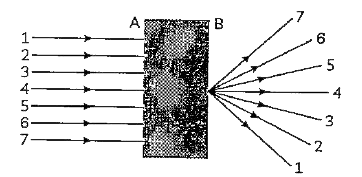Lenses made of transparent materials such as glass or plastic with curved surfaces. Diverging lenses are thicker at their edges than at their centres and make light rays passing through them spread out. Converging lenses are thicker in middle than at edges and make light rays passing through them focus at a point.
Sakshi conducts an experiment to produce an image of an object on a screen which is placed at 20 cm from the lens. She uses a convex lens of focal length 15 cm produce the sharpest image?
20 cm in front of the lens
8 cm in front of the lens
15 cm in front of the lens
60 cm in front of the lens
The correct Answer is:D
Here, v = + 20 cm f = + 15 cm , u = ?
Using lens formula
1v−1u=1f
⇒1u=1v−1f
1u=120−115
=−160
∴u=−60cm
The negative sign indicates that the object is placed in front of the lens
Similar Questions
Knowledge Check
Lenses made of transparent materials such as glass or plastic with curved surfaces. Diverging lenses are thicker at their edges than at their centres and make light rays passing through them spread out. Converging lenses are thicker in middle than at edges and make light rays passing through them focus at a point.
For lenses I and IIAP1=P2BP1<P2CP1>P2DP1 is positive and P2 is negativeLenses made of transparent materials such as glass or plastic with curved surfaces. Diverging lenses are thicker at their edges than at their centres and make light rays passing through them spread out. Converging lenses are thicker in middle than at edges and make light rays passing through them focus at a point.
A beam of light is incident on the box through the holes on side A and emerges out of the holes on the side B of the box:

Which of the following is present the boxAConcave lensBRectangular glass plateCprismDConvex lensFor a light ray passing through a prism
Aangle of deviation increases when angle of incidence is increasedBangle of deviation decreases when angle of deviation is increasedCWhen angle of incidence is increased or decreased from a particular value then in both cases angle of deviation increases.DAngle of deviation is approximately proportional to the refracting angle of prism provided prism is very thin.
Transparent materials like glass allow light to pass through them.
View SolutionWhich materials allow light to pass through them?
View SolutionA ray of light undergoes ……… on passing through a prism.
View SolutionLenses made of transparent materials such as glass or plastic with curved surfaces. Diverging lenses are thicker at their edges than at their centres and make light rays passing through them spread out. Converging lenses are thicker in middle than at edges and make light rays passing through them focus at a point.
Abhishek uses two lenses I and II of same size and same material as shown P1 and P2 are the powers of A and B. An object is kept at the same distance from the lenses between Fand 2F of each lens on the principal axis in turn Let li and la be the image formed by two lenses respectively. Which one of the following statements is correct for the images formed?

View SolutionA ray of light passing through the principal focus of a convex lens after refraction
View Solution
